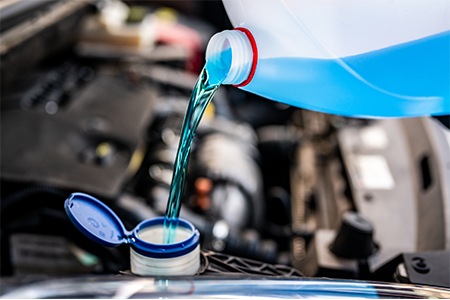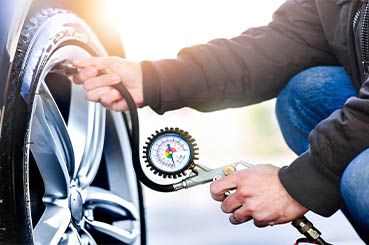Have you heard people talking about the importance of regularly changing your engine coolant, but not really understanding what it does or why you need to change it? In this article, we aim to explain the importance of engine coolant checks as well as look at what engine coolant is and what it does for your car.
We will also explain how to drain engine coolant and replenish your car with fresh engine coolant. For many people, this is something best left to the experts. But it’s always good to know what is happening when you take your car to the garage.
At Stoneacre we’ll check your engine coolant as part of our Gold Service and Platinum Service, but we can also drain and refill as part of our engine coolant change service. If you want to let us do it great. Or if you want to have a go yourself there’s everything you’ll need to know about checking and changing engine coolant below.

Jump to section
- What is engine coolant?
- What is antifreeze?
- What does antifreeze do?
- Is engine coolant anti-freeze?
- How long does anti-freeze last?
- How to check engine coolant
- How to drain & dispose of engine coolant
- How to top up engine coolant
What is engine coolant?
Engine coolant is a mixture of water and anti-freeze which helps prevent your engine from overheating. We’re regularly asked if you can put water in the engine coolant. The answer is it’s already in it. Engine coolant is a mixture of water and anti-freeze at a typical ratio of 50:50. However, some manufacturers may recommend up to a 70:30 anti-freeze to water ratio in really cold conditions.
What is anti-freeze?
Anti-freeze is a glycol-based liquid which prevents water from freezing under cold weather conditions. Anti-freeze also contains other inhibitors to help prevent engine corrosion and assist with the lubrication of the water pump and other engine parts.
What does antifreeze do?
As the name suggests, anti-freeze helps prevent water from freezing. Under normal conditions, a 50:50 mixture of anti-freeze and water is sufficient to prevent the water within your car’s cooling system from freezing.
It is important to prevent water from freezing in your cooling system because when water freezes it expands. The expansion can cause your car radiator or broken engine cases to split, resulting in costly repairs. So by keeping your engine coolant topped up and at the right concentration, you will help prevent any damage to your car’s radiator or other components should the temperature outside drop.
But that is not all anti-freeze does. It also helps to raise the boiling point of the engine coolant, which helps reduce the risk of overheating. Just like freezing, overheating can put your car components at risk of more extensive damage.
Modern anti-freeze now often contains inhibitors which help prevent scale build-up or corrosion within your cooling system as well. Give this video from our YouTube channel a watch to see engine coolant and antifreeze in action.
Is engine coolant anti-freeze? (The difference between the two)
Engine coolant and anti-freeze are similar, although there are some distinct differences. You must be aware of these if you are planning to top up your engine coolant levels yourself.
Anti-freeze is a concentrated glycol-based liquid that you have to dilute with water before use. Engine coolant is a mixture of anti-freeze and water. It is usually mixed at a rate of 50:50, although you will find the specific details in your car manual.
You can buy pre-mixed engine coolant which comes ready to use. But how do you know what engine coolant you need?
Fortunately, car manufacturers specify the exact type of engine coolant you should use in the vehicle manual. So it is easy to find out exactly which engine coolant is right for your vehicle.
How long does anti-freeze last?
When in a sealed bottle anti-freeze has an indefinite shelf-life. Once you have opened a bottle, it will keep for years if kept stored correctly in its original container.
Anti-freeze tends to last longer than pre-mixed engine coolants, although coolants still have quite a long shelf life.
However, once the anti-freeze is in your car, it is a different story. The anti-freeze itself does not degrade in your vehicle, but the additives in it which prevent corrosion start to degrade. Therefore it is recommended you always follow manufacturer guidelines on replacing engine coolant.
You can buy anti-freeze testers to measure the protection of your coolant in your cooling system, but this is not necessary. Instead, it is best to maintain the schedule of coolant change as per manufacturer guidelines.
How to check engine coolant
Most new cars have a dashboard warning light which lights up permanently if there is a problem with your engine cooling system. It is important not to ignore this warning, as doing so can result in further damage to your car. Instead, get your vehicle booked into your local garage as soon as possible to get the engine coolant checked. For more information read our post about what you should do if your engine coolant warning light comes on.
Regardless of whether your car has a warning light or not, you can also check your engine coolant level manually:
Steps to check your engine coolant
1. Find your expansion tank and locate the coolant filler cap. You can use your vehicle handbook to find the location of the cap. You must get the right cap as adding anti-freeze to your screen wash, brake fluid or power steering reservoir can cause damage.
2. Once you have located the right coolant cap and have opened it, you can check the coolant level. It should be between the minimum and maximum marks on the side of the expansion tank.
3. While you are checking your coolant level it is also a good idea to take a look at any visible cooling system hoses. A wet or white stained hose indicates a potential problem, so it is worth getting your vehicle checked out by a professional.
If you notice that your engine coolant level is low, you should take it to a garage to get checked. Most modern cars come with a sealed cooling system, so shouldn’t need topping up unless there is a problem.
At Stoneacre, we take the hassle out of checking your engine coolant and will check it as part of your car service. If it looks a bit low we’ll then recommend our engine coolant change service for £34.95 which we can do alongside the rest of the service.
How to drain engine coolant
In cars made before 2000, draining your engine oil is a relatively simple task that can be completed by following some instructions. Whereas cars built after 2000 have a more complicated system which means that the process is more in-depth, and often best left to a professional mechanic.
Regardless of whether you are going to give changing your engine coolant a go or intend to take your car to a garage, it’s good to understand more about the process of draining your oil.
It is always a good idea to check your owner’s manual for the recommended intervals and procedures. You also need to check what type of engine coolant you need to get, as using the wrong coolant can cause premature component failure and even void your warranty.
Steps to draining your engine coolant

- First, you should check your existing engine coolant for any signs of corrosion. The best way to do this is to remove a small amount of coolant using a baster. If the fluid looks brown or gunky, it indicates corrosion. So you should contact a garage to organise a professional engine flush.
- Assuming your engine coolant is ok you can proceed with draining your coolant. Raise and safely support the front end of your car on jack stands.
- Place a large drain pan under the radiator and remove the radiator cap. If your car doesn’t have a radiator cap, you need to remove the pressure cap from the coolant tank instead.
- Open the drain cock and drain the radiator. Bear in mind there are different kinds of drain cock including screw threads, quarter-turn twists and quarter-turn pull. Plastic drain cocks can get brittle over time, making them more prone to breaking. Therefore, it is a good idea to buy a spare drain cock before you begin, just in case things don’t quite go to plan when trying to remove it.
- You need to remove the radiator hose clamp and the hose from the engine to drain the rest of the coolant. Once you have drained all the engine coolant from the system, you should reconnect the clamp and radiator hose and reinstall the drain cock.
A note on how to dispose of antifreeze (UK) – Antifreeze is considered hazardous waste so should disposed of properly. The glycol in antifreeze is known to be lethal to humans if ingested so requires specific handling. Antifreeze should disposed of well away from children and wildlife too.
Garages will have proper facilities to dispose of antifreeze so taking your car to a professional means you won’t have to deal with sorting out where your old coolant should go. Your council will have a nearby facility for hazardous waste disposal so you can contain it once it’s drained from your car and take it there.
Tipping it down the drains may be the easiest way to dispose of antifreeze but is certainly not recommended as this will contaminate sewers. The antifreeze bottle should be disposed of in your main rubbish bin too as recycling it can contaminate the bin.
How to top up engine coolant
So once you’ve successfully drained your engine coolant, you will want to know how to top up your coolant. First, you need to replenish it with brand-new coolant. You should never refill your tank with the coolant you’ve just drained.
Don’t forget it is essential you use the type of coolant recommended by your manufacturer.
Another top tip is that if your manufacturer specifies you mix coolant, you need to use the specified anti-freeze and distilled water. Using distilled water is essential as it helps reduce mineral deposits building up and clogging your cooling system.
Steps to topping up engine coolant
Make sure you complete the prior steps to check your engine coolant and drain it from your car.
- Raise your car (if not still raised from draining). Raising the vehicle up helps to prevent air pockets from forming in the engine as you refill the system.
- Slowly fill your radiator or coolant tank with fresh coolant until it is about one inch below the neck of the radiator or a few inches below the full mark on your coolant tank.
- Start your engine and let the car run for a little while. As the engine warms, the coolant level should drop in the radiator or coolant tank as the thermostat has opened.
- You now need to bring the coolant level to the top of the radiator, or the ‘HOT’ mark on the coolant tank. If your manual indicates an air bleeding procedure, you should then follow this.
- Finally, you need to check for leaks, before shutting off the engine, installing the cap and lowering the car back to the ground. You can then take a test drive to make sure everything is running ok.
As already mentioned, newer cars tend to have a more complex system with specific air tools needed to complete the job. In this case, it may be more cheaper and much quicker to get a garage to change engine coolant for you.
At Stoneacre, we offer an engine coolant change service across all of our branches. Booking couldn’t be easier. You can book an engine coolant change online or contact your local Stoneacre dealership to get an appointment at a time to suits you.
Don’t forget if you have any other questions about oil coolant changes or our service procedure our service staff will be more than happy to help. You can contact your local Stoneacre branch to get more information about the process.




